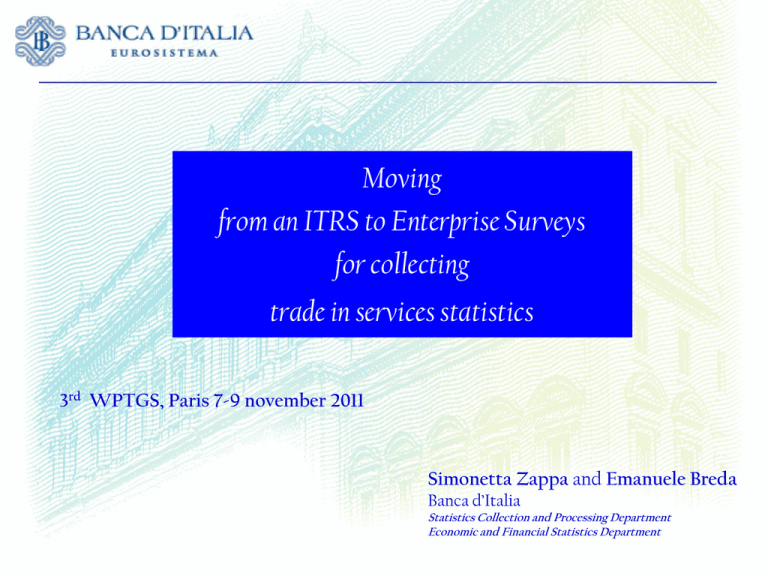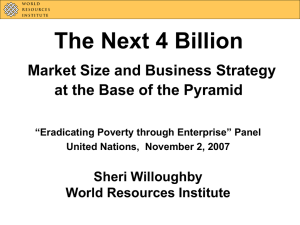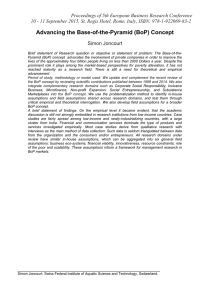Moving from an ITRS to Enterprise Surveys for collecting trade in services statistics
advertisement

Moving from an ITRS to Enterprise Surveys for collecting trade in services statistics 3rd WPTGS, Paris 7-9 november 2011 Simonetta Zappa and Emanuele Breda Banca d’Italia Statistics Collection and Processing Department Economic and Financial Statistics Department Outline of the presentation The new system: basic principles and project timetable Business Register and Sampling Techniques Data sources: the Direct Reporting system and the other sources Main results page 1 Why a new system ? 1. 2. 3. To react to prospects of decreased usability/availability of settlement data, because of: • Increasing disconnection between settlements and BOP transactions • Rising exemption threshold and prospects of dismantling of bank reporting of cross-border settlements for BOP purposes. To improve quality of statistics • Asking information to subjects directly involved in international transactions. • More precise identification of phenomena and their characteristics. To reduce the reporting burden, rationalise the system and increase its efficiency page 2 Basic principles of the new system 1. Moving from a fully-fledged ITRS to a more flexible double-entry “matrix of data sources” 2. More extensively adopting sample survey (rather census) approaches . 3. Avoiding information redundancies to the maximum extent possible 4. Using already existing data sources, originally set up for non-statistical purposes (e.g. administrative data) page 3 The new data collection system for BoP Simplified sector/item matrix for services Resident sector General government Monetary authorities Other MFIs Non-financial and insurance corporations Households and NPISHs AS = Administrative sources CB = Central bank data DR = Direct reporting IBR = Integrated Bank Reports Survey = Sample survey already existing Travel Survey Normal Bold Transport Other services Survey CB CB IBR DR AS Already defined in the old system Implemented in the new system page 4 The transition to the new system Project timetable (I) Second half of 2006 • Launch of the project. Inventory of international “best practices” During year 2007 • • • • First draft of Direct Reporting (DR) questionnaires. Pilot DR questionnaires Definition of main IT requirements for DR Sample selection, finalisation and dissemination of DR questionnaires to a sample of about 7,000 enterprises Appointment of a “DR Input Group” January – March 2008 • • “Road show” to present the direct reporting system to enterprises (19 meetings) Bid and start of “first level help desk” outsourced April 2008 –> First DR results • Start of DR in parallel with the old system, experimental phase (results not published) Second half of 2008 • • Fine tuning of the system Dedicated meetings with enterprises November 2008 –> Adaptation in the Foreign Exchange Law • BdI’s powers to 1) define reporting forms and transmission details, 2) manage sanction procedures 3) access to administrative data for statistical purposes page 5 The transition to the new system Project timetable (II) During year 2009 • • • • Analysis of results and comparisons with old system data Reminders to reporting entities and checking activities Definition of sanctions procedures Administrative data sources: start of interactions with Fiscal Authorities. December 2009 –> Publication of BdI’s DR Regulation • • Formalization and detailed definition of reporting forms, instructions, periodicity and timeliness Definition of the sanction procedure for omissions reporting, managed by the BdI September 2010 –> dissemination of new system BOP and dismantling of settlement reports • • » Last settlement system reports referred to June 2010 » July 2010 is the first reference period of new BOP data First sanctions deliberated Administrative data available During year 2011 –> backward revision of BOP series • • BOP revised back to end 2007 Long-period backward revision of BOP series page 6 Outline of the presentation The new system: basic principles and project timetable Business Register and Sampling Techniques Data sources: the Direct Reporting system and the other sources Main results page 7 Business Register and Sampling Techniques FROM TO Settlements (ITRS) Direct Reporting Bank system Business Register Enterprises The ECB regards payments data as a potentially useful tool in particular to identify the reporting population to be surveyed, i.e. to set up and maintain a register of internationally active firms. This concerns information that is readily available to the banks and that can be supplied to b.o.p. compilers in a fully automated fashion at reasonable intervals… (Opinion of the ECB, 6 January 2009) Business registers can be used as survey frames for balance of payments (BoP) surveys …. The data collection for BoP has moved considerably from transaction-based data collection to direct surveys. EUROSTAT (Business registers-Recommendations manual 2010 edition) page 8 Business Register and Sampling Techniques Business Register as a complete, integrated, dynamic and, above all, BoP-oriented instrument Complete: Italian BR includes all the enterprises potentially involved in international transactions Integrated: different sources are used at the same time, with different identification keys linked by a “Bridge Table” to obtain an homogeneous structure Dynamic: sources can change over time BoP-oriented: Flags for: listed companies firms involved in international transactions presence of FDI Auxiliary variables: balance sheet data international turnover sector of activity geographical breakdown page 9 Business Register and Sampling Techniques “Other services” Total Turnover Stratification variables for ‘other services’ Flag =1 Flag =0 • Presence of international transactions (flag) • Dimension (total turnover) 250 mln.€ 100 mln.€ 10 mln.€ Census Sample Out of sample page 10 Business Register and Sampling Techniques “Other services” – 2010 sample Enterprises Presence of international transactions Dimension (turnover) Number yes 1-10 million 49,305 22.7% 7.7% 0.0% yes 10-100 million 18,739 8.6% 20.5% 5.0% yes more than 100 million 2,281 1.1% 43.7% 91.0% no 1-10 million 136,924 63.1% 14.3% 0.0% no 10-250 million 9,615 4.4% 9.9% 0.7% no more than 250 million 122 0.1% 3.9% 3.4% Percentage % Turnover DR Flows (Previous Editions) Census Strata page 11 Outline of the presentation The new system: basic principles and project timetable Business Register and Sampling Techniques Data sources: the Direct Reporting system and the other sources Main results page 12 Data sources and Methodologies Data sources OTHER SERVICES Methodologies Communication services Aggregation of items Financial services deriving from the Computer & Information services new data sources Royalties & licences Direct Reporting - TTN (firms) Business services (except for merchanting) AS – MF: Tax Authority Database (households) Personal, cultural and recreational services IBR (banks for their own account) CB (on its own account and on account of PPAA) Administrative data Government services Insurance services Construction services Business services - Merchanting Old methodology, including administrative data integrations New methodology, fully compliant with international standard page 13 Data sources’ contributions (I) For some sub-items Direct Reporting share is around 100% of the total: Communication services Computer & Information services Royalties & licences Construction services page 14 Data sources’ contributions (II) For other sub-items a number of sources contribute to the total amount: Financial services Insurance services Business services 34% CREDITS 19% DEBITS 66% 10% 71% 58% CREDITS 63% DEBITS Government services 15% 5% 8% 67% DEBITS DEBITS 22% 92% CREDITS CREDITS 2% 95% CREDITS DEBITS Personal, cultural and recreational services 40% 33% 95% 8% 5% 8% 84% 5% DR- TTN 95% IBR MUTUAL FUNDS MF BI page 15 Data sources • Direct Reporting - TTN (firms) • MF - Tax Authority Database (households) • IBR (banks for their own account) • BI (on its own account and on account of PPAA) • Administrative data page 16 Data sources The Direct Reporting System General features One survey in the non financial area: “TTN – Transazioni Trimestrali Non finanziarie” (Quarterly Non financial Transactions) Reference population: non-financial and insurance corporations Global sample for 2010 included around 3,200 firms General principles Every firm must report only with reference to its own operations Every transaction between a R and a NR is relevant even if it’s an intragroup transaction Valuation according to accrual principle Conversion of foreign currency transactions: figures must be expressed in euros The reporter must communicate, with a specific tool, the eventual absence of transactions to be reported, in every reference period page 17 Data sources The Direct Reporting System TTN: Transazioni Trimestrali Non finanziarie (Quarterly Non financial Transactions) • Periodicity: Quarterly • Timeliness: + 1 month • Contents: flow data broken down by: o o o o type of transaction country of counterpart currency flow direction (credit/debit) page 18 Data sources The Direct Reporting System TTN: Transazioni Trimestrali Non finanziarie (Quarterly Non financial Transactions) Type of transaction classification • Services Communication services Construction services Insurance services Financial services Computer & Information services Royalties e licences Business services Personal, cultural & recreational services Government services • Acquisition/Disposal of intangible assets • Current and capital transfers • Salaries & wages (only if paid by the reporter) page 19 Data sources • Direct Reporting - TTN (firms) • MF - Tax Authority Database (households) • IBR (banks for their own account) • BI (on its own account and on account of PPAA) • Administrative data page 20 Other Data sources Administrative source Tax authority information Monitoraggio Fiscale: The enforcing resident banks to monthly report to legal framework the Ministry of Finance cross-border settlements performed on behalf of resident households. The Ministry of Finance transmits these data in an aggregated form to the Bank of Italy for statistical purposes once a year. Periodicity: Monthly Timeliness: 10 months after the end of the tax reference year Coverage: all households performing transactions with foreign counterparts through the resident bank over the threshold of 10,000 € Contents: amount of transaction with details on: • Type of transaction • Country • Direction (credit/debit) page 21 Outline of the presentation The new system: basic principles and project timetable Business Register and Sampling Techniques Data sources: the Direct Reporting system and the other sources Main results page 22 Main results “Other services” - old vs new system Year 2009 - million of euros 60,000 50,000 45,195 40,022 40,000 32,153 30,000 29,747 20,000 10,000 0 -10,000 -13,042 -20,000 CREDITS DEBITS -10,275 BALANCE Old system New system page 23 Main results “Other services” by sub-item old vs new system Year 2009 - million of euros 35.000 CREDITS Old system 30.000 New system 25.000 22.107 20.000 16.646 15.000 10.000 5.000 3.756 2.091 272 1.226 2.245 836 2.677 1.531 2.778 1.330 563 852 798 229 1.003 960 0 CONSTRUCTION SERVICES COM M UNICA TION SERVICES INSURA NCE SERVICES FINA NCIA L SERVICES COM P UTER & INFORM A TION SERVICES ROYA LTIES & LICENCES B USINESS SERVICES P ERSONA L SERVICES GOVERNM ENT SERVICES page 24 Main results “Other services” by sub-item old vs new system Year 2009 - million of euros 35.000 31.996 Old system DEBITS 30.000 New system 25.000 21.161 20.000 15.000 10.000 5.000 3.830 3.727 1.542 0 4.902 2.753 1.744 29 CONSTRUCTION SERVICES COM M UNICA TION SERVICES INSURA NCE SERVICES 2.987 618 FINA NCIA L SERVICES 2.529 1.259 COM P UTER & INFORM A TION SERVICES 1.434 474 1.358 ROYA LTIES & LICENCES B USINESS SERVICES P ERSONA L SERVICES 1.517 1.357 GOVERNM ENT SERVICES page 25 Main results “Other services” by sub-item old vs new system Year 2009 - million of euros 4.000 BALANCE 2.059 2.000 243 0 -316 -2.000 -4.000 -6.000 -74 -508 -908 -1.456 -1.636 -696 -1.199 -560 -245 -582 -514-397 P ERSONA L SERVICES GOVERNM ENT SERVICES -2.124 Old system -4.515 New system -8.000 -10.000 -9.889 -12.000 CONSTRUCTION SERVICES COM M UNICA TION SERVICES INSURA NCE SERVICES FINA NCIA L SERVICES COM P UTER & INFORM A TION SERVICES ROYA LTIES & LICENCES B USINESS SERVICES page 26 B E ST R IA LG IU B C M U ZE LG C A H R R EP IA U B LI C C Y P R U D S E N M A R E ST K O N IA FI N LA N FR D A N C G E E R M A N Y G R EE IR CE E LA N D LA TV LI TH I A LU U A X N E IA M B O U R G N M E A TH LT E A R LA N D S P O LA P N U O D N R IT TU E G D A K L IN G D O R M O M A N S LO IA VA K S LO IA VE N IA S PA IN S W E D E H N U N G A R Y A U Main results Old vs new system – “Other services” by country Year 2009 - million euros 6,000 CREDITS 5,000 NEW OLD MIRROR 4,000 3,000 2,000 1,000 - page 27 The reconstruction of pre-2008 balance of payments data (1) After the publication of the new system data for 2008-10, back-data have been revised: the main items of current account and capital account have been reconstructed backwards up to 1970 (before 1991 revisions are negligible); the main items of the financial account have been reconstructed backwards up to 1997. page 28 The reconstruction of pre-2008 balance of payments data (2) The current account balance has been revised upwards (around 75 billions of euros between 1999 and 2007, in cumulated terms), mainly because of an upward revision of capital income balance (data from the old system did not include non-distributed income of capital accumulation funds); the increased debtor position in 2007-10 stocks determined an upward revision of capital inflows for the previous years; these diverging patterns between current account and financial account balances determined a significant increase in negative cumulated errors and omissions. page 29 Italy's balance of payments (old and revised data) (millions of euro; cumulated data from 1990) 200000 net current and capital account (new) net current and capital account (old) financial account (new) financial account (old) 150000 100000 50000 0 -50000 -100000 1990 1991 1992 1993 1994 1995 1996 1997 1998 1999 2000 2001 2002 2003 2004 2005 2006 2007 page 30 Italy's balance of payments (old and revised data): income balance (as percentages of GDP) 0.5 0 -0.5 -1 net income (new) net income (old) -1.5 1999 2000 2001 2002 2003 2004 2005 2006 2007 page 31



